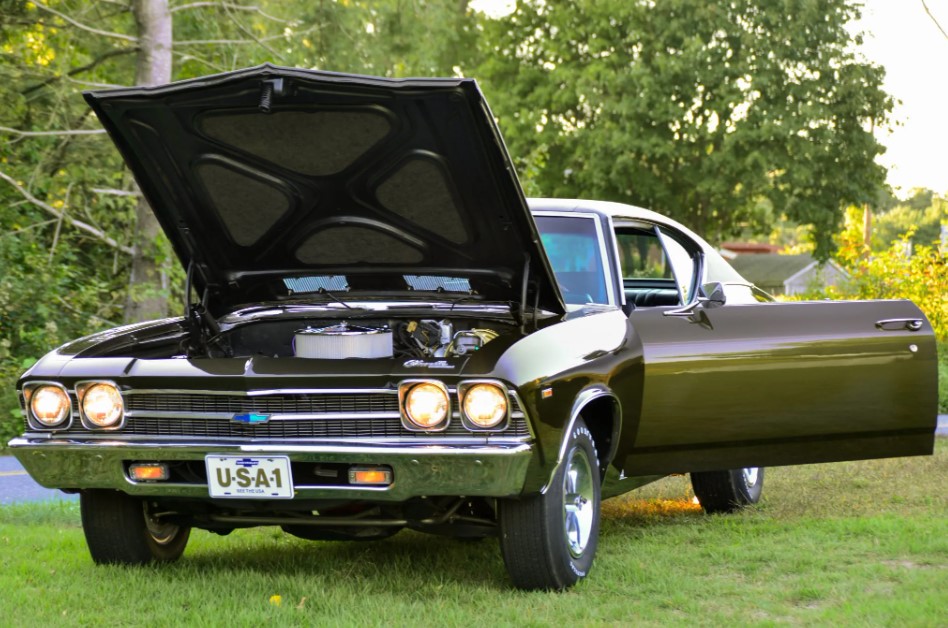The Studebaker Avanti was a unique and iconic American sports coupe produced by the Studebaker Corporation from 1962 to 1963, and later by Avanti Motors from 1965 to 2006. It was designed as a high-performance personal luxury car, intended to revive Studebaker's reputation and compete with European sports cars.
-1686042812x1024.jpg)
1. Design
The design of the 1962 to 1963 Studebaker Avanti was created by a team led by industrial designer Raymond Loewy, who aimed to give the Avanti a modern and futuristic appearance.
Sleek and Aerodynamic Shape
The Avanti featured a sleek, low-slung profile with a forward-leaning stance. Its aerodynamic design was achieved through a combination of a long, sloping nose and a tapered rear end. The car's body was made of fiberglass, which allowed for more flexibility in shaping the curves and contours.
-1686042858.jpg)
"Coke Bottle" Silhouette
One of the most distinctive aspects of the Avanti's design was its "Coke bottle" shape. The car had voluptuous curves that accentuated its fenders and rear haunches, giving it a muscular and athletic appearance.
-1686042884x1024.jpg)
Grille and Bumper Integration
The Avanti had a unique front grille design that was integrated into the front bumper. The grille featured a horizontal mesh pattern and was flanked by recessed quad headlights, which were concealed behind retractable covers. This design gave the car a clean and smooth front fascia.
-1686042905.jpg)
Frameless Curved Windshield
The Avanti was one of the first American production cars to feature a frameless curved windshield. The windshield extended upwards into the roofline, providing a panoramic view for the driver and contributing to the car's aerodynamics.
-1686042924.jpg)
Minimalistic Side Panels
The Avanti had sleek, uninterrupted side panels with minimal ornamentation. The absence of external door handles further contributed to the car's smooth and clean lines. The door handles were instead concealed beneath the beltline and were opened by pushing buttons inside the cabin.
-1686042941x1024.jpg)
Innovative Interior
The Avanti's interior was designed to be luxurious and comfortable. It featured bucket seats, a center console, and a full array of gauges and controls. The dashboard had a modern and clean design, with circular gauges and a symmetrical layout.
-1686042956x1024.jpg)
2. Engine
The Studebaker Avanti was offered with several engine options during its production years. Here are the main engines that were available for the 1962 to 1963 Studebaker Avanti:
R1 289 V8
The base engine option was a 289 cubic inch (4.7-liter) V8 engine. It was equipped with a single four-barrel carburetor and produced 240 horsepower.
-1686042978x1024.jpg)
R2 289 V8
The R2 engine was a more powerful version of the 289 V8. It featured a Paxton supercharger, which boosted the horsepower to 289 horsepower.
R3 289 V8
The R3 engine was the most potent version available for the Avanti. It was also equipped with a supercharger, but it had larger carburetors and other modifications, resulting in an impressive output of 335 horsepower.
-1686042993x1024.jpg)
The Avanti's engine options were all based on Studebaker's existing 289 cubic inch V8 engine. The addition of superchargers in the R2 and R3 models significantly increased their performance capabilities. These engines were known for their smooth power delivery, contributing to the Avanti's reputation as a capable and high-performance sports coupe.
-1686043016.jpg)
3. Performance
Acceleration
The Avanti's acceleration varied depending on the engine option. The base R1 289 V8 engine produced 240 horsepower, allowing the Avanti to accelerate from 0 to 60 mph (0 to 97 km/h) in around 8 seconds. The R2 and R3 supercharged versions offered even quicker acceleration.
-1686043041x1024.jpg)
Top Speed
The Avanti's top speed also varied based on the engine configuration. The R1 model had a top speed of approximately 125 mph (201 km/h), while the R2 and R3 models could reach speeds in excess of 140 mph (225 km/h).
-1686043086x1024.jpg)
Handling
The Avanti's performance extended beyond straight-line speed. Its aerodynamic design, combined with features like disc brakes and a well-tuned suspension, contributed to excellent handling characteristics. The Avanti was praised for its agility and stability on the road.
-1686043109x1024.jpg)
Braking
One of the Avanti's notable features was its standard disc brakes, which were relatively rare in the early 1960s. The disc brakes provided exceptional stopping power and improved overall braking performance compared to drum brakes commonly used at the time.
-1686043128x1024.jpg)
4. Cultural Significance
Design Innovation
The Avanti's design was a departure from the traditional American car designs of its time. It embraced a sleek and futuristic aesthetic, featuring aerodynamic lines, hidden headlights, and unique body contours. The Avanti's design broke new ground and showcased the possibilities of automotive styling, influencing future car designs.
-1686043143.jpg)
Raymond Loewy's Legacy
The Avanti was designed by renowned industrial designer Raymond Loewy and his team. Loewy is widely regarded as one of the most influential designers of the 20th century, and his work on the Avanti further solidified his reputation. The Avanti stands as a testament to Loewy's ability to combine elegance, innovation, and functionality in his designs.
-1686043160x1024.jpg)
Limited Production and Collectibility
The Avanti had a relatively short production run, with Studebaker producing them from 1962 to 1963. Later, Avanti Motors produced them from 1965 to 2006. The limited number of Avantis produced, especially in their original Studebaker-built form, contributes to their collectibility and desirability among classic car enthusiasts.
-1686043186x1024.jpg)
Racing Success
The Avanti achieved notable success in racing and competition. In 1963, an Avanti R2 set 29 international and American stock car speed records at the Bonneville Salt Flats. These achievements helped solidify the Avanti's reputation as a performance-oriented car.
-1686043200x1024.jpg)
Iconic American Design
The Avanti represents an iconic piece of American automotive design. It embodied the spirit of American innovation and captured the attention of car enthusiasts and the general public alike. The Avanti's unique styling and powerful performance contributed to its status as an American classic.
-1686043216x1024.jpg)
Pop Culture References
The Studebaker Avanti has made appearances in various forms of popular culture, including movies, television shows, and literature. Its distinctive design and vintage charm have made it a recognizable and evocative symbol of its era.
-1686043232x1024.jpg)
-1686042839.jpg)

-1685871148.jpg)
